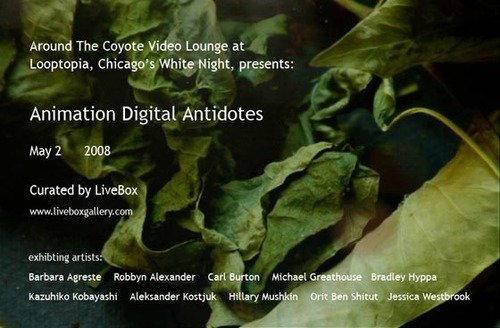Barbara Agreste
Robbyn Alexander
Carl Burton
Michael Greathouse
Bradley Hyppa
Kazuhiko Kobayashi
Aleksander Kostjuk
Hillary Mushkin
Orit Ben Shitut
Jessica Westbrook
1/5/2008
Animation - Digital Antidotes
Different venues, Chicago
An event curated by LiveBox. Digital animation processes now used by artists encompasses a fast array of approaches, from simple tools to industrial software used to create the latest Pixar blockbuster.

Curated By LiveBox
Animation has moved to the center of our moving-image culture. America’s children spend more time engaging anime and avatars than they watch network TV. Animated formats compete with main line cinema, and new media artists commonly utilize and manipulate animation processes in their projects. A proliferation of easy to use animation software such as Flash has introduced animation to artists. Digital animation processes now used by artists encompasses a fast array of approaches, from simple tools to industrial software used to create the latest Pixar blockbuster.
Digital Antidotes is a selection of video art that is digitally animated.
Exhibting Artists:
Barbara Agreste, Robbyn Alexander, Carl Burton, Michael Greathouse, Bradley Hyppa, Kazuhiko Kobayashi, Aleksander Kostjuk, Hillary Mushkin, Orit Ben Shitut, Jessica Westbrook.
http://www.liveboxgallery.com/Looptopia.html
Part One: Point, Line and Plane
Abstract rhythms emerge from music, line and shapes. These artists use generative video loops to create dynamic imagery, some reminiscent of the great Oscar Fischinger.
Bradley Hyppa, USA, ''Lunchtime in the Fidi'', generative video loop, 2007, (3:53 min). Pedestrian movement across the urban landscape is captured by video taken from the 14th floor above the Financial District in San Francisco. These rhythms are used to create abstract computer generated renderings (using the open source Processing platform) to provide insight into both the objectives and methods of social construction.
Kazuhiko Kobayashi, Japan, “ Ensemble”, :Monochrome”, “Rotary Plate”, collection of generative looped videos. Rhythm and line merge to create audio and video music.
Part Two: Familiar Twists
Exciting contemporary animation that references methods used at least a century before cinema, such as stop action and puppetry, but enhanced through new animation tools.
Jessica Westbrook, USA, “Sugar Free”, 2007, (2:45 min). Sugar Free investigates the complex of consumption as a binary ratio: package=energy, desire=need. Deploying motion graphics, a sequence of manipulated packages present a new way of looking at the biology and physiology of consumption.
Hillary Mushkin, USA, “As we go on”, 2005, (6:57 min) Hand drawn images move in animation. A hand drawn sketch of a man’s face is the canvas for an array of manipulations suggesting an internal dream world.
Orit Ben Shitut, Israel, “The Long from Inside”, 2007, (3:14 min). The Long from Inside deploys film, collage and motion graphics. The composition gives a glimpse into a psychological state reflecting both internal and external realities. At its heart is a reconstructed narrative of a cinematic world that slowly begins to rupture.
Barbara Agreste, Italy/London, “Reptilica”, 2008, (6:00 min). Reptilica is half animation half a film where real people perform. It Starts with a doll which is animated with the stop motion technique, she is searching through the many dry leaves that rest on the floor, something she has seen or felt passing by, but she can't seem to find it.
Aleksander Kostjuk, Croatia, “Nino the Adventurer”, 2006, (3:38 min). Little animated character dealing with objects and happenings that come from above.
Michael Greathouse, USA, “The Banquet”, 2007, (6:40 min). Inspired by film noir and b/w Hollywood horror films, my most recent work is a series of short video loops produced exclusively with composited computer animation. In these videos there is no beginning and no end, only a single moment continually repeating like a skipping record. Questions are not answered; the story is implied but never defined.
Carl Burton, USA, “Drift”, 2007, (10:21 min) A refreshing bit of experimental storytelling that uses the otherworldly yet familiar imagery of microscopic life as its backdrop.
Robbyn Alexander, USA, “Limerence”, 2006, (5:00 min). Limerence is a time-based self-portrait created with hand-painted, directly manipulated found film footage, re-appropriated music and found sounds. Both a cinematic loop and a moving painting of light, it's enveloping, hypnotic rhythms of light, image and sound induce analtered state. Viewers are invited on a psychological ride through the subconscious mind in its creative experience of being in love.
Different venues
Chicago



